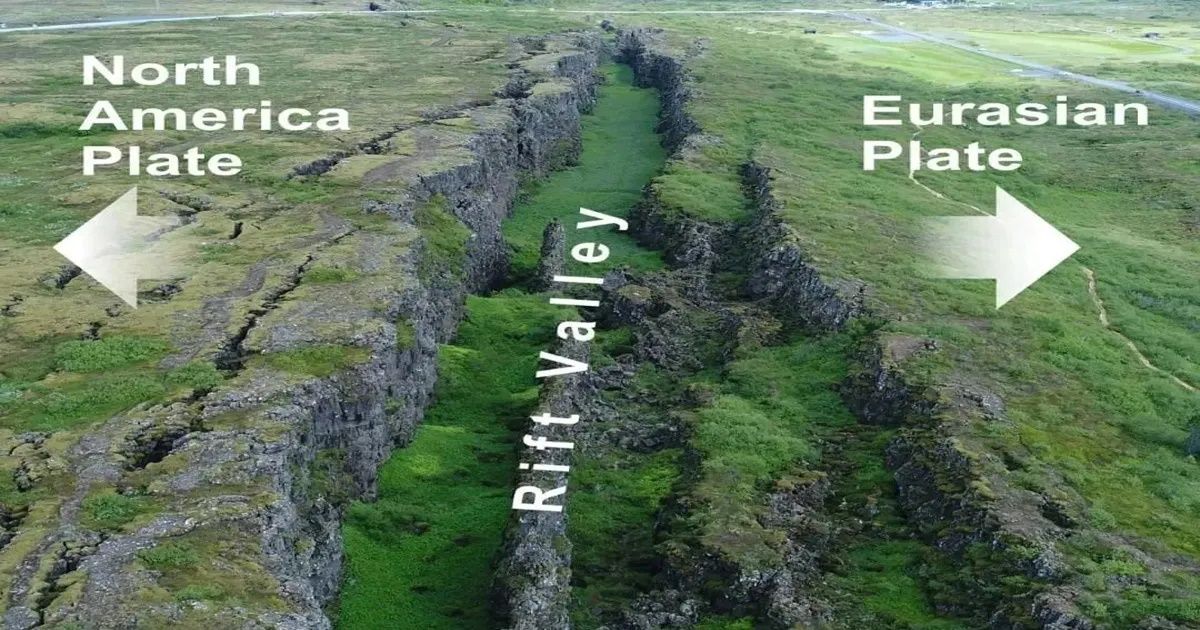

Mid-Atlantic Ridge On Iceland
The Mid-Atlantic Ridge (MAR) is a submarine ridge located along the floor of the Atlantic Ocean, which wraps around the globe for more than 65,000 km. It is the longest and the most extensive chain of mountains on earth, but being located underwater, more than 90% of this mountain range remains hidden from view. There are only a few places on earth, where it juts out of the surface of the ocean, in the form of a few islands, one of which is Iceland. The ridge goes directly across Iceland and can be seen at Thingvellir National Park or the Reykjanes peninsula.
The Mid-Atlantic Ridge is the boundary where the Eurasian and North American tectonic plates meet and move apart from each other

The ridge was discovered in the 1950s. Its discovery led to the theory of seafloor spreading and general acceptance of Wegener’s theory of continental drift. The MAR separates the North American Plate from the Eurasian Plate in the North Atlantic, and the South American Plate from the African Plate in the South Atlantic. These plates are still moving apart, so the Atlantic is growing at the ridge, at a rate of about 2.5 cm per year in an east-west direction.
Iceland’s formation is closely linked to the Mid-Atlantic Ridge, and its current unique geology and geothermal features are due to the tectonic activity along the ridge. Iceland is situated directly above the ridge’s westernmost section. The movement of these plates creates new oceanic crust and causes volcanic and seismic activity, which is why Iceland is a land of active volcanoes, hot springs, and rugged terrain. The process of Iceland’s formation began around 25 million years ago when the North American and Eurasian tectonic plates began to move apart.

It is a massive underwater mountain range that runs through the middle of the Atlantic Ocean







Image Credits: Muhammed Zeynel Ozturk
Recommended Videos
 Scientists Discover A New and Rare Species of Jellyfish at a Depth of 2.3 Miles Beneath the Ocean Surface!38 views
Scientists Discover A New and Rare Species of Jellyfish at a Depth of 2.3 Miles Beneath the Ocean Surface!38 views This Scorpion Found in a Mine Has Turned Into Copper And Here’s How That’s Possible233 views
This Scorpion Found in a Mine Has Turned Into Copper And Here’s How That’s Possible233 views-
Advertisements
 A Guide to Pet Budgie Birds14148 views
A Guide to Pet Budgie Birds14148 views 62 Of The Worst And Funniest Attempts At Photoshop47 views
62 Of The Worst And Funniest Attempts At Photoshop47 views Belgian Canaries have the best hairdos...37062 views
Belgian Canaries have the best hairdos...37062 views Meet The Coveted Frillback Pigeon, A Bird With Curly Feathers!214 views
Meet The Coveted Frillback Pigeon, A Bird With Curly Feathers!214 views Artist Uses Makeup To Turn Into 15 Nightmarish Monsters196 views
Artist Uses Makeup To Turn Into 15 Nightmarish Monsters196 views Astonishing Photos Of Caterpillars By Igor Siwanowicz That Will Surprise You66 views
Astonishing Photos Of Caterpillars By Igor Siwanowicz That Will Surprise You66 views
You may also like
 40 Breathtaking Nature Pics That Won The 2020 International Photography Awards
40 Breathtaking Nature Pics That Won The 2020 International Photography Awards  There Is A Flower That Has Petals That Look Like Little Hummingbirds
There Is A Flower That Has Petals That Look Like Little Hummingbirds  Rare pink dolphin spotted off the coast of North Carolina
Rare pink dolphin spotted off the coast of North Carolina  Woman Sets Up A Feeder Cam For Birds In Her Yard And The Photos Are Extraordinary (75 New Photo)
Woman Sets Up A Feeder Cam For Birds In Her Yard And The Photos Are Extraordinary (75 New Photo)